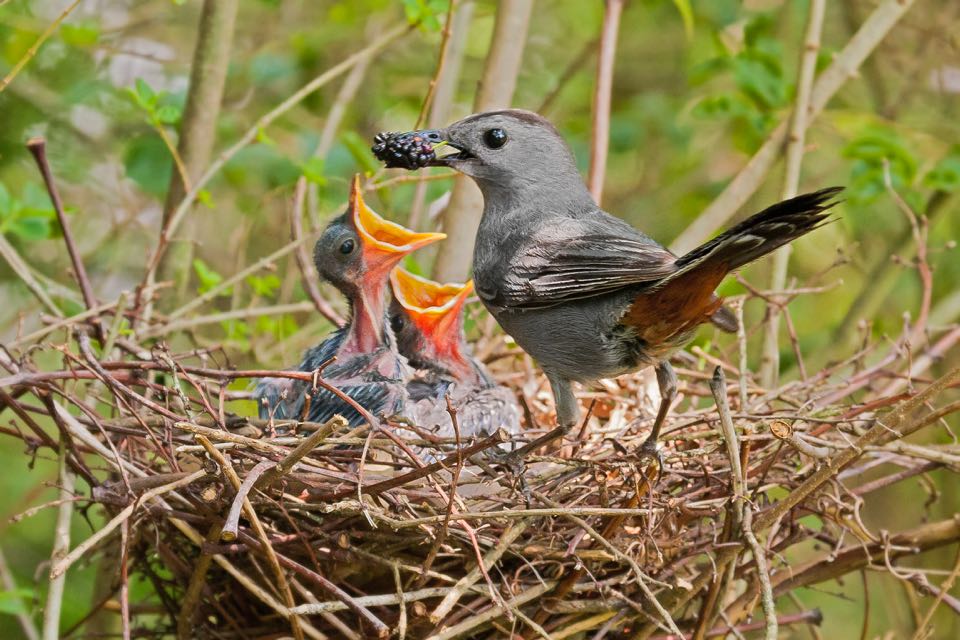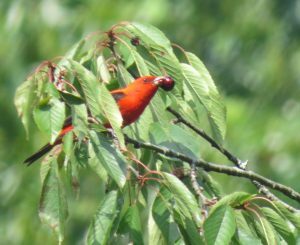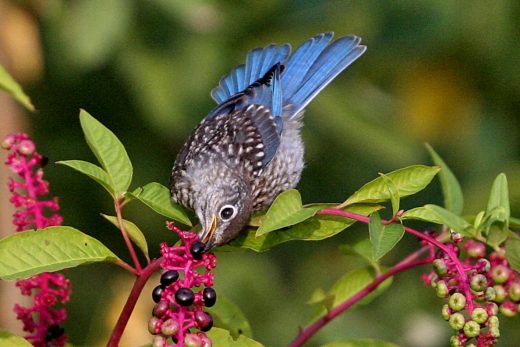By Steven Hopp

Gray Catbird feeding mulberries to nestlings (Bob Schamerhorn)
(This article was contributed by Dr. Steven Hopp, an adjunct Professor at Emory and Henry University and the region 7 Atlas coordinator)
I serve as the VABBA2 regional coordinator for region 7, in the westernmost end of the state. Like many of you, I spend some days out working on atlas activities, and some days I spend working in our garden. Just below our garden (the land is very sloped) we have a couple of huge old-time cherry trees. The variety is called blackheart, which are small (big-pea sized) and which ripen in mid-June. It is a super food resource and I have noted an amazing parade of birds over the years, providing diversion from garden work. But until our current Breeding Bird Atlas I have never thought carefully about how these birds were using these cherries, particularly in the context of feeding young. This season I watched numerous birds carrying cherries away from the tree, and on one occasion I watched a pair of Northern Mockingbirds repeatedly carrying cherries to their nestlings, alerting me to the possibility that birds were carrying cherries to their young. I also watched a downy woodpecker feeding cherries to a fledgling. A lot of times I watch them eat a few cherries then take one for the road. Over two weeks I watched twenty-one different species eating cherries, with many of them carrying cherries away from the tree:

Scarlet Tanager munching cherries (Steven Hopp)
Yellow-billed Cuckoo
Red-bellied Woodpecker
Downy Woodpecker
Hairy Woodpecker
Pileated Woodpecker
Blue Jay
Tufted Titmouse
Wood Thrush
American Robin
Gray Catbird
Brown Thrasher
Northern Mockingbird
European Starling
Cedar Waxwing
Eastern Towhee
Scarlet Tanager
Northern Cardinal
Red-winged Blackbird
Common Grackle
Northern Oriole
Orchard Oriole
On the surface, applying the “carrying food” (CF) code to the birds leaving the trees would make sense. But there is also continual bickering among the different species, so it’s possible that the carrying aspect is simply individuals taking the cherries to where they can eat them in peace. Because cherries don’t have a lot of protein, essential for rapidly growing young, how likely is it that these birds are feeding cherries to their young?
A review of the ornithology literature quickly told me that feeding cherries and berries to nestling is actually quite common. I found reference to the following specifically feeding cherries to their young:

Eastern Bluebird fledgling eating pokeweed berries (Dave Kinneer, https://secondcousindave.smugmug.com)
Eastern Kingbirds
American Robin
Wood Thrush
Eastern Bluebird
Cedar Waxwings
Northern Mockingbird
Gray Catbird
Scarlet Tanager
Baltimore Oriole
I also found reference to the following feeding not cherries, but other berries to their young (blackberry, elderberry, mulberry):
Brown Thrasher:
Yellow-billed Cuckoo
Red-Bellied Woodpecker
Apparently people have puzzled over cherry-feeding to nestlings for over a century. Early observers (as early as 1897) seemed concerned that nestlings might choke on the cherry pits, but found that they digested the good part, then disgorged the cleaned pits. Later discussion of feeding berries focused on the nutrition, noting that the lack of protein in fruits and berries were not suitable for rapid nestling growth. The issue seemed to be solved by Eugene Morton, a former research scientist at the Smithsonian Conservation and Research Center, in Front Royal Virginia, who found that while protein is essential for early growth and thermoregulation, as nestlings become able to regulate their own body temperatures, they can more easily digest berries. So, while berries don’t provide the best food for rapid growth, the ease of collecting them allows the parents to gather many quickly. Indeed, observations by Morton and others show that feeding cherries to nestlings is much more common as they get older. So most of the cherry picking I watched was probably being carried to young.
~Dr. Steven Hopp, Emory, VA

